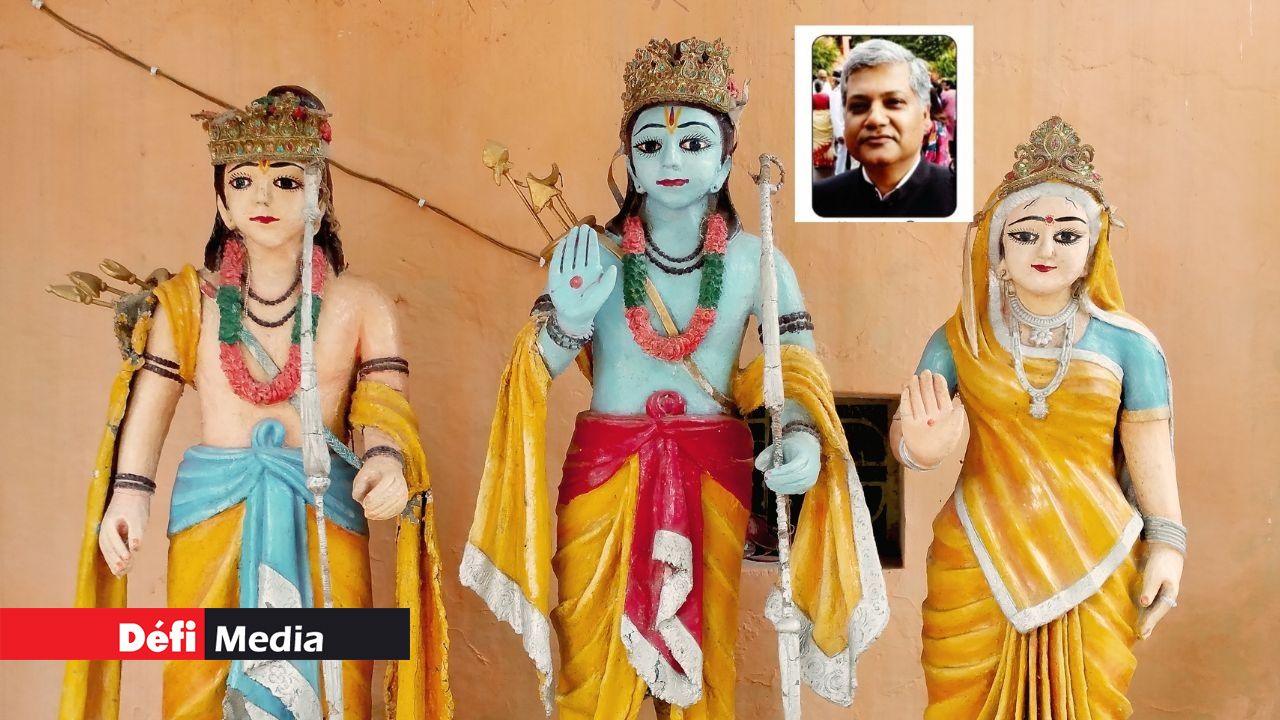
Rama, Ramayana and Much more…. By Dr Shubhankar Mishra, Deputy Secretary General, World Hindi Secretariat Mauritius
Publicité
In our childhood days, we all fondly remember listening to stories from our grandmothers. Their fairy tales and epic adventures were always captivating. One such epic story is that of Prince Rama, the eldest son of King Dasharatha of Ayodhya. Everyone loved Rama for his kind and noble nature, and King Dasharatha planned to crown him as the future king. However, Queen Kaikeyi's intervention disrupted everything. She demanded that her son Bharata be crowned instead and Rama be sent into exile for fourteen years. Lord Rama listened to his father and respected his wishes even though he did not bear a grudge against his stepmother, Kaikeyi.
Rama accepted his fate and embarked on a journey of self-discovery with his loyal wife, Sita, and devoted brother, Lakshmana. Together, they faced numerous challenges, including the evil demoness Shurpanakha. When Shurpanakha's nose was cut off in self-defence, it angered the demon king Ravana, who kidnapped Sita and took her to Lanka. Faced with adversity, Rama sought the help of the monkey king, Sugriva, and his mighty general, Hanuman. Hanuman leapt across the ocean, found Sita, and assured her that help was coming. A great battle ensued between Rama's army of monkeys and Ravana's demon forces. With the help of Hanuman and his army, Rama ultimately defeated Ravana and rescued Sita. After fourteen long years of exile, Rama, Sita, and Lakshmana returned to Ayodhya. The people welcomed them back with open arms, and Rama was finally crowned as the rightful king. The kingdom flourished under his just and constructive rule, and the people enjoyed peace and prosperity.
My Nani used to sum up her story with a moral of the story. She ended the story of Rama and Sita, saying that the story teaches us that we can always emerge stronger, no matter our challenges, if we remain constructive and determined.
As I graduated, I found the saga of Ram and Sita to be much more than a story; it is a piece of our rich legacy, scripture, history, literature and much more that has an enduring impact on our society. The epic tale of Ramayana is genuinely inspiring. It teaches us humility, loyalty, and courage through the characters of Lord Rama, Sita, Laksman, Hanuman, Bharata, etc.
Values imbibed from Ramayana
Rama's actions show us how to be an ideal son, and Ravana's downfall teaches us the importance of humility. Sita's unwavering support for her husband and Laksman's loyalty are admirable. Hanuman's lesson in loyalty is invaluable as well. When Bharata discovers what his mother did, he seeks Rama in the forest and asks him to take his rightful place as king. Rama refused, so Bharata put his sandals on the throne to symbolise his authority, promised to rule as regent, and offered his devotion to Rama. They set an example for us to face life's challenges with dignity, compassion, and bravery. The timeless teachings of Ramayana encourage us to create a better world where respect, compassion, and inclusivity are cherished and upheld.
Shri Rama: The Ideal Man in Honour (Maryada Purushottam)
The name Rama (incarnation of Vishnu) is synonymous with Shri Ramachandra (beautiful, lovely moon), the seventh avatar of Vishnu, in Indian tradition. However, it is worth noting that Parashurama and Balarama are two other Ramas mentioned in Indian tradition. Rama, the Vishnu avatar, is also referred to by various names, such as Dasharathi and Raghava (the descendant of Raghu). Swami Vivekananda once famously said, " Rama, the ancient idol of the heroic ages, the embodiment of truth, of morality, the ideal son, the ideal husband, the ideal father, and, above all, the ideals all, the ideal king." Rama is widely accepted as a hero of ancient India. With his virtues and character, Rama inspires us all to strive towards being the best version of ourselves.
Ramayana: Shri Rama's Journey
The Ramayana story appears in several other Sanskrit texts, such as the Mahabharata, the Bhagavata Purana, the Vishnu Purana, and the Agni Purana. Shri Ramachandra's story is briefly mentioned in the Mahabharata but extensively narrated in the Ramayana, also known as "Rama's Journey." Ramayana, the most vivid and vibrant ancient epic of India, is a story that has stood the test of time. It is a tale of adventure, excitement, love, and war intricately woven into the life of Rama and his family. 'Mula Ramayana' in Sanskrit is generally recognised as the oldest version attributed to the sage Narada. It is believed that sage Narada passed on the knowledge to sage Valmiki, who authored Ramayana in Sanskrit, the oldest version of Ramayana currently available. The Valmiki Ramayana is considered the primary source of Rama's life. Numerous Sanskrit versions of the Ramayana also offer a wealth of spiritual teachings and fascinating stories. These versions include the Aadhyatma Ramayana, the Vasistha Ramayana, the Laghu Yoga Vasishtha, the Ananda Ramayana, the Agastya Ramayana, and the Adbhuta Ramayana, among others.
Goswami Tulsidas, a Sanskrit scholar, had a noble vision to bring the story of Shri Rama closer to the ordinary person and the intellectual alike. To make this happen, he wrote 'Ramcharitmanas' in about 1574 in Awadhi, a dialect of Hindi, to enable anyone to sing, meditate, and perform the story of Rama. This masterpiece not only made the story of Rama more accessible to people but also created a new cultural tradition of Ramlila, a dramatic enactment of the text.
It is worth noting that the Ramayana and Ramcharitmanas, two of the most significant works of Indian traditions, are divided into seven chapters, each with its unique message.
It's fascinating to learn that there are multiple versions of Ramayana in Indo-Persian literature, in addition to the well-known Sanskrit and Hindi versions. Some of these versions are translations from Sanskrit of Valmiki Ramayana, while others are based on the Ramcharitmanas of Tulsidas. Mulla Abdul Qadir Badayuni translated the first Persian Ramayana. This version is based on the original Sanskrit Ramayana and includes 176 illustrations, which the emperor Akbar said to have ordered for the translation (Ransafwi.com). It is currently preserved in India's Sawai Man Singh, Jaipur Museum.
The Legacy of Ramayana: India and Beyond
The Ramayana is an Indian Hindu epic poem that has captured people's fascination from different walks of life. Its universal appeal is evident in the numerous versions of Ramayana that exist today, with around three hundred versions depending on the counting methods. These adaptations are available in various Indian languages, including Buddhist and Jain adaptations, such as the "Katha Ramayana" (Assamese, Assam), Krittivas Ramayana (Bangla, Bengal), Kamba Ramayana (Tamil, Tamilnadu), Ramavatara Charita (Kashmiri, Jammu and Kashmir), Dandi Ramayana or Jagamohan Ramayana (Odiya, Odisha), Adhyatma Ramayanam Kilipattu (Malayalam, Kerala) and Maithili Ramayana (Mithila region of Bihar) to name a few. The story has captivated India and transcended borders, spreading to many Asian countries outside India, such as Burma, Indonesia, Cambodia, Laos, Philippines, and China. We may find other versions of the Ramayana outside India, such as Reamker (Glory of Rama) in Cambodia, Ramakien in Thailand, Phra Lak Phra Ram in Laos, Kakawin Ramayana of Indonesia, Rajah Magandiri of the Philippines, and Yama Zatdaw in Burma, Siddhi Ramayana of Nepal, among others, as well. Its long-lasting relevance and universal appeal are remarkable and continue captivating audiences worldwide.
The Legacy of Ramayana in Mauritius
The Ramayana has a deep-rooted legacy in Mauritius, which is an essential part of the country's cultural heritage, rich history, and traditions. The Indian immigrants who arrived in the early 19th century brought with them their customs and religious texts, including the Ramayana and Hanuman Chalisa. For the indentured labourers, the Ramayana provided comfort and hope, inspiring them to find solace in the story of Rama and his pursuit of righteousness.
Today, the Ramayana Centre of Mauritius stands as a testament to the enduring legacy of the Ramayana. The Centre was established by an act passed in the National Assembly of the Republic of Mauritius in 2001 to promote and propagate the Ramayana's spiritual, social, and cultural values. It serves as a symbol of deep reverence and respect that Mauritians have for the Ramayana and a beacon of hope for future generations to keep its spirit alive.
Ram Lalla Viraajmaan
The upcoming 'Prana Pratishtha' ceremony of the deity Bhagwan Ram Lalla in Ayodhya is of immense importance for Hindus worldwide. The ancient practice of 'Pran Pratistha' holds a great significance in the Hindu faith. This momentous occasion, scheduled for January 22nd, 2024, will offer devotees a unique opportunity to connect with their faith on a deeper level at the birthplace of Lord Rama. May the deity 'Ram Lalla, the infant form of Rama and an avatar of Vishnu, bestow peace, prosperity, and happiness upon the universe.
****
The writer is a Government of India official representing the country in the World Hindi Secretariat, Mauritius as Deputy Secretary General. He previously served as Joint Director, Ministry of Education, Government of India. He has authored several books on language, culture and education for all age groups. Views expressed are personal.

Notre service WhatsApp. Vous êtes témoins d`un événement d`actualité ou d`une scène insolite? Envoyez-nous vos photos ou vidéos sur le 5 259 82 00 !
















![[Info Soirée ] : « Nu pe anvi konn la verite »](https://defimedia.info/sites/default/files/styles/square_thumbnail/public/thumbnail040425.jpg?itok=HyUaetyX)





